Bridging Science and Spirit: Branding That Honors the Full Spectrum of Holistic Therapy
Many holistic therapists feel a quiet tension when they try to describe their work. They care deeply about helping others heal, yet when it comes to presenting themselves, they hesitate. They want to sound professional enough for clients who value structure and evidence, but they also want to stay true to the intuitive, soulful parts of what they do. Holding both can feel like walking a tightrope.
Some therapists tell themselves they need to sound more clinical to be taken seriously. Others worry they sound too abstract, too spiritual, too open. That internal tug-of-war leaves many feeling disconnected from their own voice. They start second-guessing their language, their visuals, even their credibility. The effort to appear balanced often turns into self-editing that hides the heart of their work.
This disconnect reaches beyond marketing. Therapists begin to question where their work fits within the wider professional landscape. They wonder whether clients understand what they do or if colleagues see their methods as legitimate. The more they try to sound acceptable, the more distant they feel from the essence of their practice. The result is not a lack of expertise or care, but a quiet fear of being misunderstood.
If this feels familiar, you are in good company. Many practitioners sit in this same space, wanting to integrate both evidence and energy in a way that feels honest. This is the bridge between science and spirit, the space where holistic therapy branding truly lives.
By the end, you will have a framework for showing up with both heart and authority. You will understand how integration builds trust, attracts clients who resonate with your depth, and allows you to feel more authentic in every piece of your business. The goal is simple: Create a brand that feels like you, rooted in skill, guided by intuition, and true to the kind of healing you bring into the world.

The Therapy Branding Dilemma: Too Woo or Too Clinical
Every therapist who works at the intersection of science and spirituality eventually faces a branding choice. Do you lean toward professionalism and clinical language, or do you embrace the intuitive, soulful nature of your work? For most, neither extreme feels right.
Holistic therapy branding invites you to stop choosing sides. Instead of deciding between science or spirit, you learn to weave them together in a way that feels authentic. Clients today are seeking both credibility and connection. They want to know you are grounded in evidence but also emotionally attuned.
The problem is not that therapists are doing something wrong. It is that most branding advice forces them into narrow categories. Marketing templates often reward clarity over depth, while spiritual branding trends can drift into abstraction. The truth is that your work likely contains both data and depth, both structure and sensitivity. Your brand deserves to reflect that fullness.
Why Your Brand Is an Extension of Your Therapeutic Presence
Your brand is not just a logo or a tagline. It is a living reflection of how you hold space for others. Every visual choice, word, and tone communicates your presence before a client ever steps into your office.
Think of branding as the energetic introduction to your practice. A grounded, compassionate therapist will naturally design and write in a way that feels safe and human. A therapist who values creativity and exploration might choose softer colors, organic shapes, or storytelling copy that feels expansive.
When clients visit your website or social media, they are not simply analyzing information. They are sensing how it feels to be with you. The energy of your brand either mirrors your therapeutic approach or creates dissonance. When there is alignment, trust begins to build immediately.
Branding, when done well, becomes an extension of your therapeutic ethics. It signals integrity, empathy, and transparency—qualities that matter deeply in both therapy and marketing.
From Clinical Logos to Compassionate Language
Many therapists begin their branding journey with a focus on professionalism. They choose clean fonts, neutral colors, and structured layouts. These can communicate clarity, but if they lack warmth, they can also feel distant.
A subtle shift in tone can make a meaningful difference. Instead of defaulting to procedural or administrative phrasing, consider language that feels conversational and collaborative. The message can remain professional while still sounding human and approachable.
Compassionate language helps clients feel at ease. It replaces the rigidity of medical language with words that convey care and presence. This approach does not erase professionalism—it enriches it.
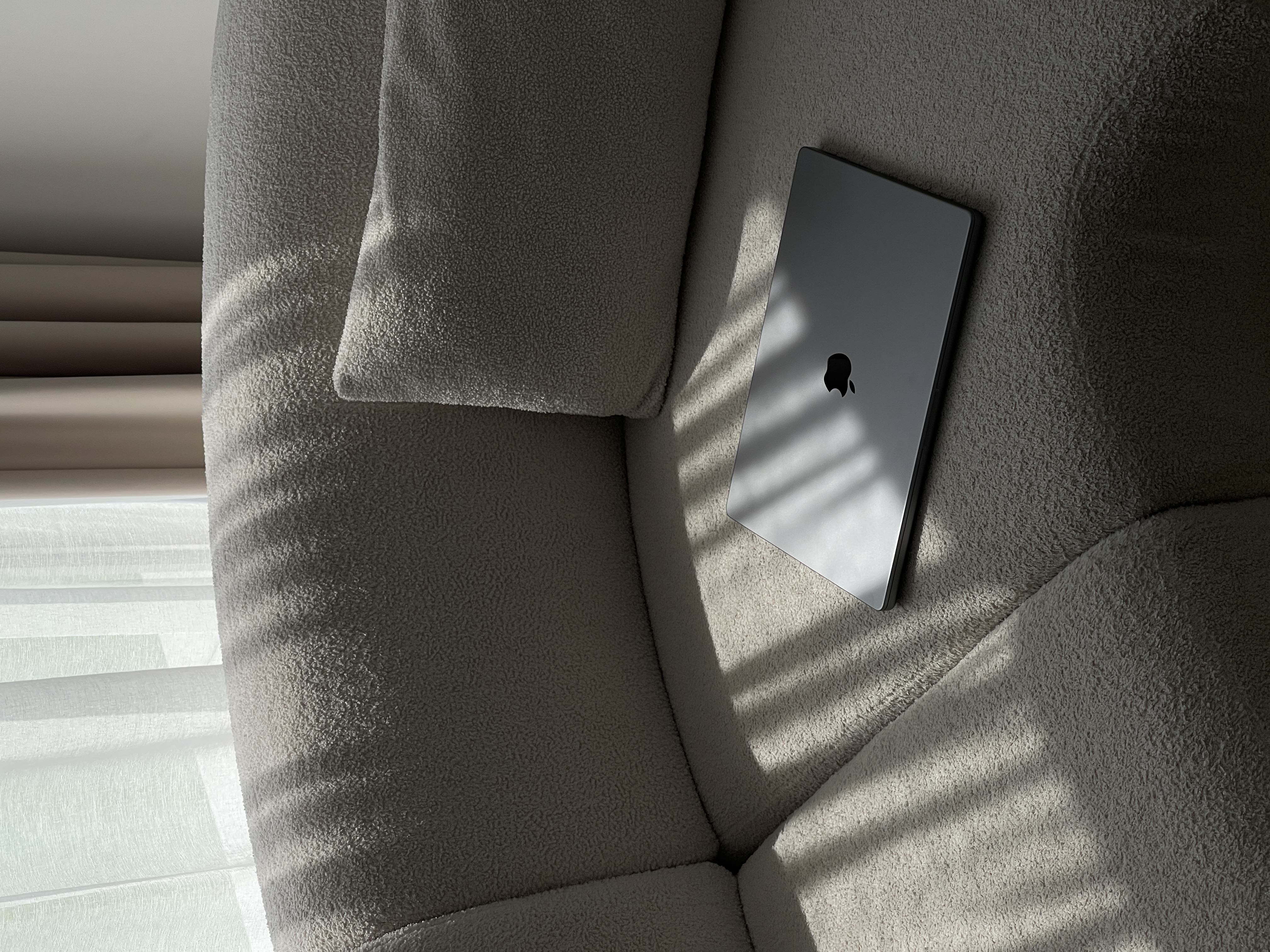
The Science Behind Trust: How Clients Subconsciously Evaluate Your Brand
Trust is built long before credentials are read. The human brain processes cues of safety and resonance within seconds. Clients are constantly scanning for signs that communicate calm, steadiness, and sincerity.
Color, tone, typography, and spacing all send subtle signals. Cool blues, soft neutrals, and rounded shapes evoke calm and predictability. Harsh contrasts, sharp lines, or overly clinical language may feel cold or detached. This does not mean bright colors or bold fonts are wrong, but they must match your energy.
When branding feels misaligned—for instance, when your visuals feel corporate but your work is deeply embodied—clients experience a quiet dissonance. Something feels “off,” even if they cannot name it.
Research in design psychology confirms that congruence between message and appearance increases perceived trustworthiness. In other words, when your words, visuals, and presence align, people relax. They sense authenticity and integrity.
Cognitive Dissonance: When Branding and Presence Do Not Match
Clients are highly intuitive, even those who are more analytical. They pick up on inconsistencies between what is said and what is felt. If your website claims to offer trauma-informed care but uses overly sterile imagery or rigid language, the subconscious message becomes “controlled” rather than “caring.”
True alignment happens when what you show outwardly reflects who you are inwardly. A brand that mirrors your real presence invites trust at a deep level.
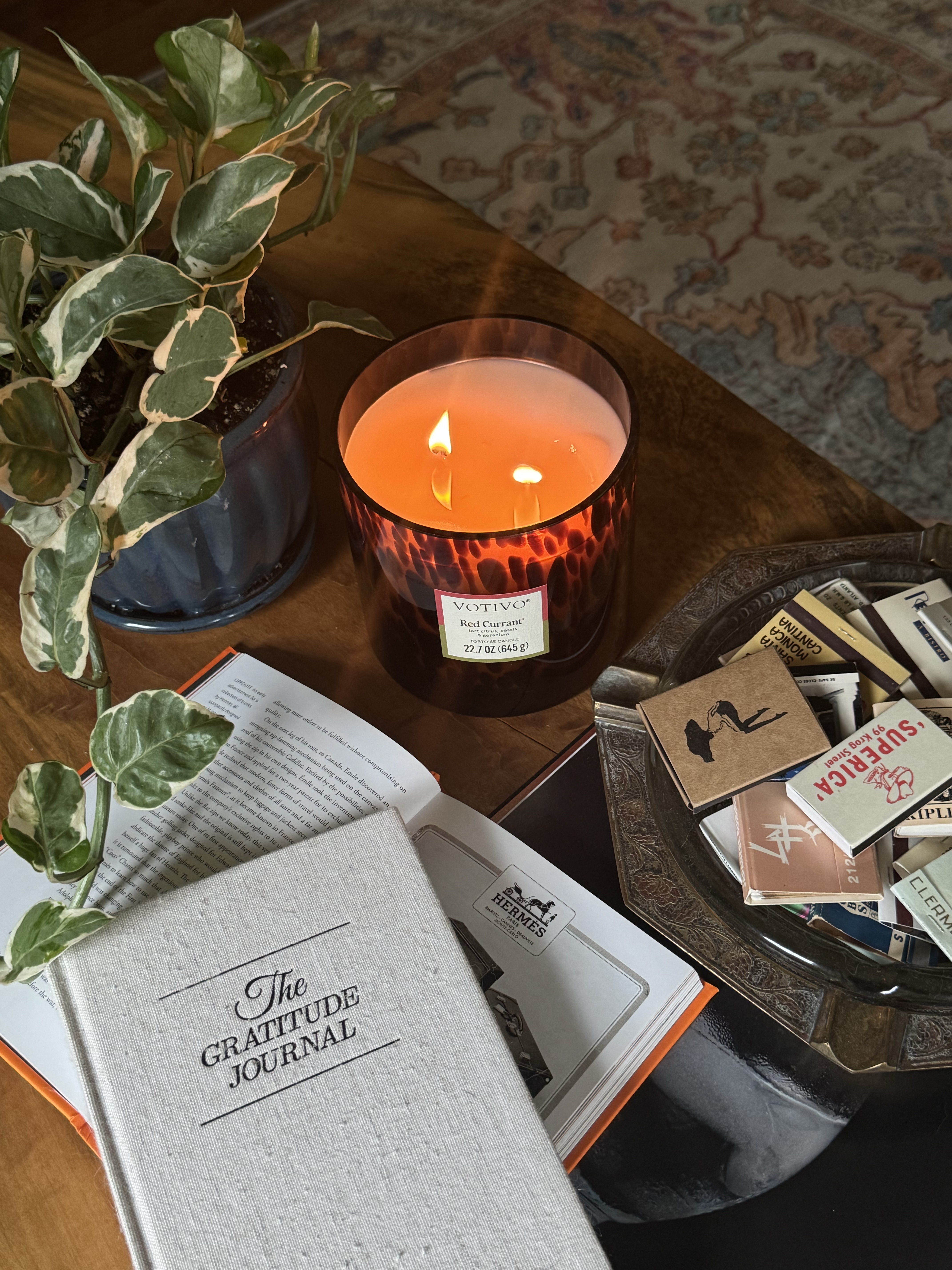
The Spirit of Healing: Infusing Meaning and Energy Into Your Brand
If science builds credibility, spirit adds depth. Spirituality in branding is not about crystals, symbols, or mysticism unless those genuinely belong to your practice. It is about energy and intention.
Every brand carries a tone, a frequency that can be felt. Clients can sense when something has been created with care versus when it was assembled quickly to appear professional. Energy translates visually, emotionally, and linguistically.
Infusing meaning into your brand begins with authenticity. Ask yourself what you want people to feel when they encounter your work. Calm? Grounded? Reassured? The clearer you are about that emotional intention, the easier it becomes to express through design, photography, and tone.
Soul-Led Branding vs. Trend-Led Aesthetics
Soul-led branding grows from the inside out. It reflects your essence and values rather than chasing what looks popular. Trend-led branding, on the other hand, may appear polished but often lacks emotional depth.
When you create from soul, your message matures with you. It becomes timeless rather than trendy. It can hold nuance and sincerity. Soul-led branding also creates deeper client loyalty because it feels real, not rehearsed.
Finding Your Middle Path: Blending Professionalism and Soul
Finding your middle path means designing a brand that holds both clinical credibility and soulful authenticity. It is about integrating logic and intuition, evidence and empathy.
A helpful way to start is to define the archetype that best represents your energy. Are you a Healer, a Guide, a Scientist, or a Mystic? Each archetype carries natural strengths and communication styles. Once you know which energy feels most authentic, you can shape your visuals and words around it.
Next, identify your core brand energies. For most therapists, there is a blend of structure (the clinical side) and flow (the intuitive side). The goal is not a perfect fifty-fifty balance but a natural rhythm that feels sustainable.
Finally, align your messaging with both evidence and emotion. You can use client-centered language that references research while remaining warm and inviting. For example, instead of “I specialize in evidence-based mindfulness interventions,” you might say, “I help clients reconnect with calm through mindfulness practices grounded in research and compassion.” Both convey professionalism, but one speaks to the heart as well as the mind.
Blending professionalism and soul allows you to show up as your whole self—confident, ethical, and real.

The Three Pillars of Integrated Branding
Creating a brand that feels both credible and soulful does not happen by chance. It emerges from conscious alignment between three essential elements: credibility, connection, and authenticity. Together, these form a foundation that can hold both your professional integrity and your intuitive depth.
Pillar One: Clinical Credibility
Credibility is the foundation of trust. It comes through in clear communication, transparent qualifications, and thoughtful boundaries. It does not require perfection or polish; it simply asks for honesty and consistency.
Highlight your credentials, modalities, and ethical commitments in language that feels conversational rather than defensive. A sentence like “I integrate somatic and evidence-based approaches to help clients find steadiness in their bodies” communicates both skill and compassion.
Credibility also means owning your scope of practice. Clients feel safe when they sense your integrity. You do not have to prove expertise through formality; you demonstrate it through clarity and grounded presence.
Pillar Two: Emotional Resonance
While credibility builds safety, emotional resonance builds connection. This is the quality that helps potential clients feel understood before they even meet you.
Emotional resonance begins with empathy in your messaging. Speak to what your clients are actually experiencing, not just the services you offer. Instead of listing modalities, describe the transformations you facilitate: the ability to breathe again after burnout, to reconnect after years of disconnection, to trust one’s own intuition after trauma.
It is this resonance, this sense of being seen, that helps clients feel drawn to your work.
Pillar Three: Spiritual Depth
Spiritual depth is not about religious language or symbolism. It is about presence. It is the subtle energy of sincerity that runs through everything you create.
This depth might be expressed in your writing, your photography, or even the spaciousness of your design. When a therapist’s brand carries spiritual depth, it feels calm, grounded, and quietly confident.
The combination of these three pillars, credibility, resonance, and depth, creates a brand that feels balanced and whole. Clients can trust it intellectually and feel it intuitively.

Visual Design That Speaks to Both Sides of the Brain
The visual dimension of your brand is more than decoration. It is psychology in motion. Design translates your energy into form, influencing how people feel when they interact with your presence online.
A holistic brand communicates through both hemispheres of the brain. The left responds to structure, clarity, and organization. The right responds to emotion, imagery, and flow. When design honors both, it mirrors the therapeutic experience itself: grounded yet human, thoughtful yet intuitive.
The Aesthetic Spectrum: Minimalist and Mystical
Every therapist’s visual identity falls somewhere along a spectrum. On one side lies the minimalist aesthetic, structured, neutral, and contained. On the other lies the mystical, textured, soft, and symbolic. Both hold value.
Minimalism conveys professionalism and simplicity, but it can feel sterile if it lacks warmth. Mystical aesthetics can feel soulful but may appear less stable if overused. The art is in finding the harmony point that matches your work.
Think of your visuals as an atmosphere rather than a statement. Your color palette, imagery, and typography should evoke the feeling of being in session with you.
Color as an Emotional Language
Color psychology offers a nuanced way to express the mood of your brand. Earth tones communicate steadiness and containment. Blues and greens invite calm and trust. Soft neutrals create spaciousness and approachability.
Rather than choosing colors based on preference, consider choosing them based on how you want people to feel. Ask yourself what emotion best represents the healing space you create. Then allow that answer to guide your palette.
When design elements align with the felt sense of your work, your brand becomes an embodied invitation rather than a visual performance.
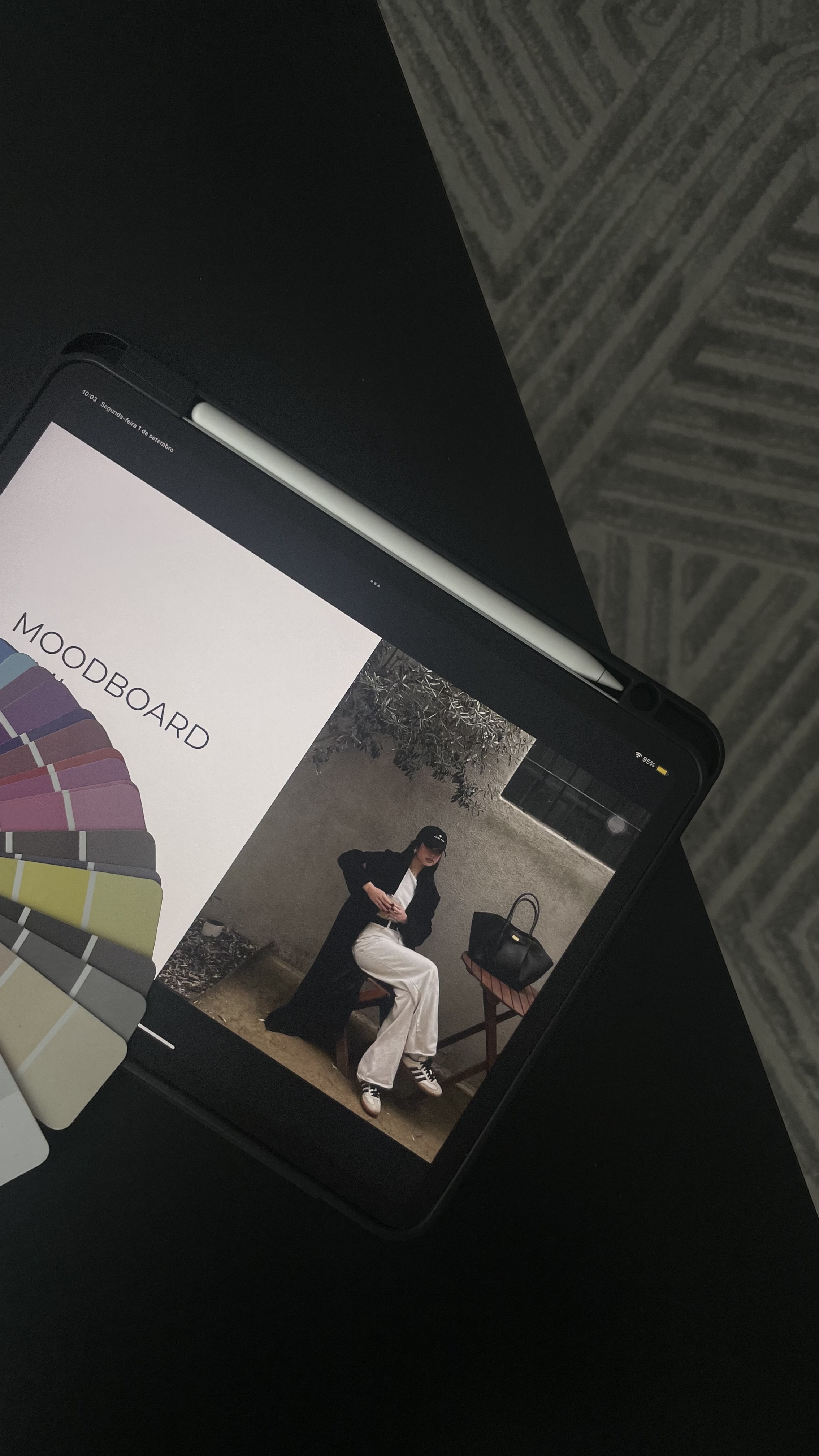
Messaging That Feels Both Safe and Soulful
Your words carry energy. They are often the first impression of your presence, so they must hold both clarity and care. The most effective messaging speaks to both the intellect and the nervous system; it informs and soothes at once.
Avoid the extremes of sterile professionalism or vague spirituality. A message that feels grounded and clear yet emotionally attuned will naturally invite trust.
For example, instead of saying “I help clients process trauma through somatic integration techniques,” you might say, “My work helps people reconnect with their bodies and find steadiness after overwhelming experiences.” The second sentence conveys the same skill, but it does so with warmth and accessibility.
When your words reflect the tone of your sessions, measured, calm, and compassionate, your brand becomes an authentic preview of the experience you offer.
The Power of Story
Storytelling is one of the most human ways to communicate truth. In therapy branding, story builds connection without oversharing. It gives shape to your values and helps potential clients understand the journey you facilitate.
A well-told story can show transformation without resorting to dramatic claims. For example, you might describe how you began integrating body-based work into your sessions after noticing that clients were expressing emotions physically as much as verbally. That kind of narrative communicates evolution, humility, and insight.
Stories help clients see themselves in your work. They do not just read about your approach; they feel its impact.

Building Ethical Authority Without Losing Magic
Professional credibility and spiritual resonance can coexist when ethics guide the expression of both. Ethical authority in branding is not about rigid formality; it is about alignment between what you offer and how you communicate it.
Transparency is the foundation. Be clear about your training, limitations, and modalities. Clients respect honesty. It helps them feel secure in choosing to work with you.
Equally important is how you speak about practices rooted in spirituality or indigenous wisdom. Use language that is respectful, specific, and non-appropriative. Acknowledge the origins of methods you draw from, and share how you have been trained to use them responsibly.
When your brand honors both science and spirit through integrity, it becomes a quiet form of authority. People feel your credibility not because you claim it, but because every part of your message reflects care.
Web Design as an Embodied Brand Experience
A therapist’s website is often the first embodied experience of their brand. It holds energy just like a physical therapy space does. Visitors will not consciously analyze every design decision, but they will feel its overall coherence.
Your website should mirror the emotional flow of a session: clarity at the beginning, grounding in the middle, and relief toward the end. The goal is not just to impress but to guide the visitor gently toward understanding and trust.
Intuitive layout choices, balanced white space, and accessible language create a sense of safety and orientation. This approach aligns with the principles outlined in The Ultimate Guide to Web Design for Therapists Who Want More Clients, where design becomes a reflection of therapeutic presence rather than a marketing gimmick.
When your digital space feels attuned to the nervous system, steady, warm, and clear, it helps clients imagine what it would feel like to sit with you in real life. That is the quiet power of embodied web design.
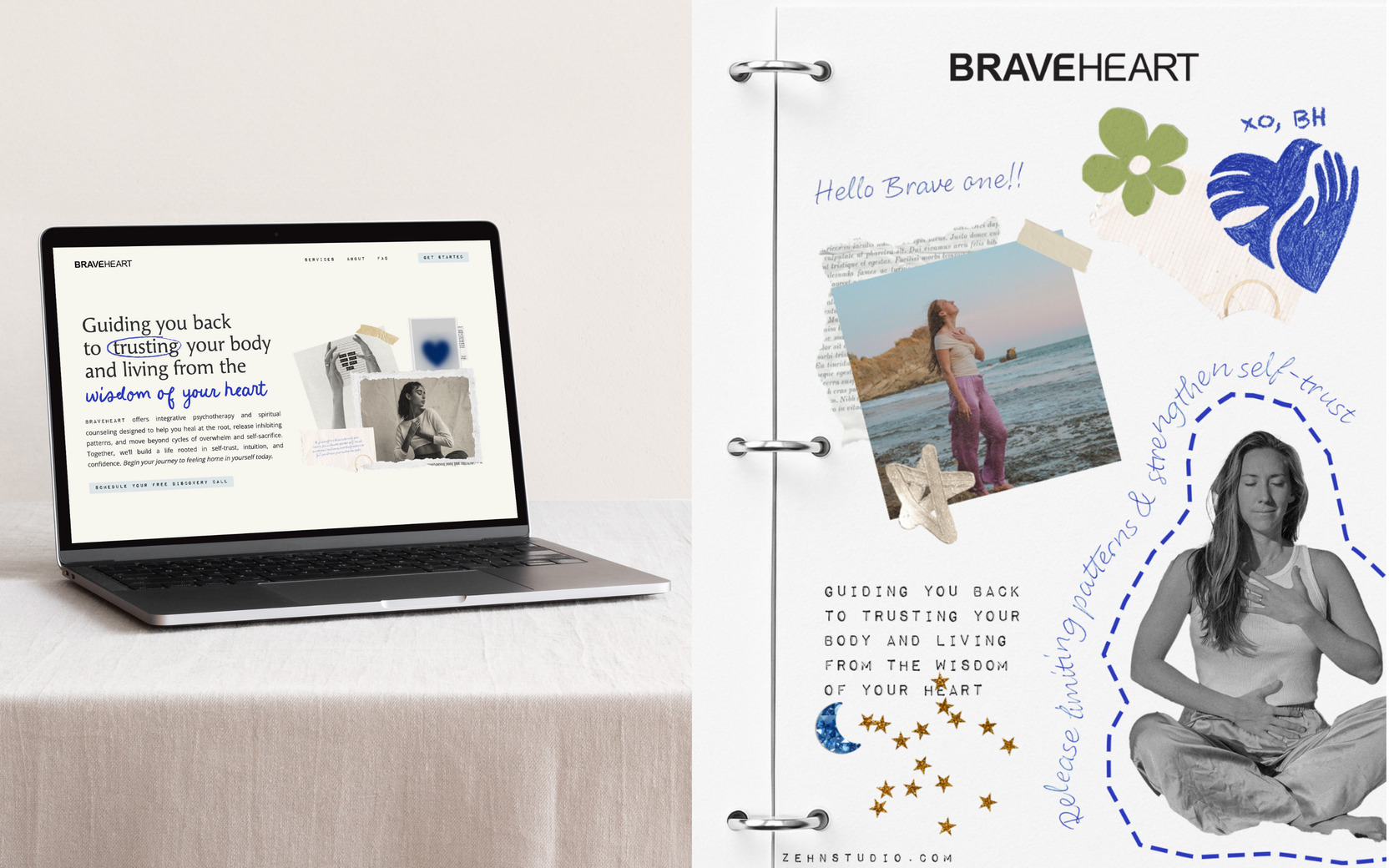
The Role of Photography and Imagery in Therapist Branding
Photography carries emotional weight. The images you choose can communicate compassion, professionalism, and humanity faster than words ever could.
Authenticity is key. Stock photos can work if chosen with care, but overly staged or artificial imagery creates distance. Photos that show genuine emotion, natural light, and grounded presence resonate more deeply.
Think of each image as a reflection of your relational stance. Does it feel invitational? Does it evoke calm or connection? The right imagery should feel like an extension of your therapeutic space, warm, respectful, and alive.
Energy also translates through visuals. A photograph that feels aligned with your practice will have a sense of quiet truth to it. Clients might not consciously notice why they feel drawn to it, but their bodies will recognize the congruence.

Common Branding Pitfalls for Holistic Therapists
Even the most thoughtful practitioners can fall into subtle traps when creating their brand. These missteps are rarely about lack of effort; they are usually the result of trying to balance too many expectations at once.
The most common pitfalls are over-spiritualizing or over-clinical branding. Both come from a place of care, yet both can unintentionally obscure authenticity.
When a Brand Becomes Too Spiritual
A therapist who leads with the spiritual side of their work might create a brand that feels transcendent but lacks structure. The language becomes ethereal, the visuals too symbolic, and the message loses clarity. Clients may sense beauty but struggle to understand what the work actually involves.
This happens when a practitioner’s intuition is fully expressed but their clinical grounding is hidden. A brand without structure can unintentionally make potential clients question its credibility, even if the work itself is deeply skilled and ethical.
You can bring balance back by introducing clear, concrete information. Describe how your approach works in practice. Name the methods you use and the kinds of transformation they support. Structure gives your intuitive work a container that clients can trust.
When a Brand Becomes Too Clinical
The opposite happens when therapists lead entirely with credentials and professionalism. Their websites read like academic papers, their colors are restrained, and their language is precise but impersonal.
Clients respect the professionalism but may feel emotionally distant from it. They cannot sense the warmth or intuitive presence that defines the therapy experience. A brand that overemphasizes the mind often loses the heart.
Restoring balance in this case means softening tone and texture. Replace overly technical language with compassionate phrasing that invites reflection and connection. Small details like imagery, color, and word rhythm can reintroduce warmth without sacrificing professionalism.
.jpeg)
How to Audit Your Brand for Alignment
A brand audit is less about critique and more about reflection. It is an opportunity to ask whether your external presentation still feels true to who you are today.
Over time, therapists evolve. Their methods deepen, their voice matures, and their client base becomes more refined. A brand that once felt right may start to feel a little out of tune. Conducting an alignment audit allows you to bring everything back into resonance.
The Alignment Audit Checklist
Use these guiding questions to assess your brand’s coherence:
- Do my visuals still reflect the emotional tone of my sessions?
- Does my website language sound like my real voice in the therapy room?
- Are my credentials and approaches communicated clearly and honestly?
- Does my content feel both professional and personal?
- Is there any area where I feel I am holding back or overcompensating?
If you notice tension in any of these areas, that is valuable information. Alignment does not mean perfection; it means harmony between how you practice and how you present yourself.
Gathering Reflective Feedback
Sometimes we are too close to our own work to see it clearly. Inviting feedback from trusted colleagues or even long-term clients can offer perspective. Ask them what they feel when they encounter your website or materials. Do they experience the same warmth, curiosity, and professionalism they feel in session?
Listen for alignment. The goal is not to please everyone but to create a brand that mirrors your truest presence.
Building a Brand Ecosystem That Extends Beyond the Screen
Your brand is not confined to your website. It lives in every point of contact a client has with you, from your social media posts to your onboarding emails and even your office space. Each moment of interaction carries a tone.
A cohesive brand ecosystem ensures that tone remains consistent everywhere. If your website feels calming and clear, but your emails sound abrupt, the energy shifts. Alignment across platforms deepens trust and makes the client’s experience feel seamless.
Consistency Across Platforms
Keep your brand language, colors, and visual cues consistent wherever you appear. Consistency communicates reliability. It tells your audience that the same care they feel on your website will be present in your sessions.
This does not mean everything has to match exactly. It simply means every element should belong to the same emotional family.
Integrating Offline Touchpoints
Branding also extends into the physical world. The atmosphere of your therapy room, your intake process, even the way you end a session all contribute to the brand experience.
When your physical environment mirrors the tone of your digital presence, clients experience coherence. The visuals, words, and energy all communicate the same message: steadiness, authenticity, and care.

Case Studies: Brands That Bridge Science and Spirit
Integration is not abstract; it takes form through practice. In our collaborations with therapists, we have seen how branding can become a mirror of a practitioner’s inner alignment. When design, language, and energy come together with intention, a brand begins to express the same balance of structure and soul that defines effective therapeutic work.
Two of our clients, BraveHeart Psychosomatic Therapy & Wellness and Metamorphia Holistic Therapy, illustrate how holistic branding can translate depth and professionalism into a clear, embodied presence.
BraveHeart Psychosomatic Therapy & Wellness
When Vanessa approached us to create the brand for her new practice, BraveHeart Psychosomatic Therapy & Wellness, she was stepping into private practice for the first time. Her vision was rooted in somatic therapy, trauma-informed care, and spiritual exploration. She wanted a brand that felt alive, creative, and compassionate without losing the grounded ethics that define her work.
We began by listening closely to the emotional atmosphere of her sessions. Her approach was both steady and expressive, helping clients regulate their nervous systems while reconnecting to their inner vitality. That contrast—structure and movement, safety and freedom—became the conceptual foundation for the brand.
The logo emerged as the central symbol of that vision. A hand releasing a bird that forms the shape of a heart captures the duality at the core of BraveHeart’s mission. It represents containment and release, the therapist’s holding and the client’s expansion, the meeting of science and spirit.

Visually, we chose vibrant blues and green accents to reflect renewal, trust, and growth. The website extended that symbolism through layered textures and collage-inspired details that gave a tactile, human quality to the design. Each element was intentional: artistry balanced by clarity, creative warmth supported by structure.
The result is a brand that feels both professional and soulful. It conveys the intelligence and care of clinical work while inviting curiosity, openness, and emotional safety. Clients often describe BraveHeart’s presence as “alive” and “trustworthy,” which is precisely the synthesis Vanessa hoped to create.
BraveHeart’s brand demonstrates what happens when visual identity is built not from trend, but from truth. It becomes less about aesthetics and more about resonance—an honest reflection of therapeutic presence made visible.

Metamorphia Holistic Therapy
Metamorphia Holistic Therapy brought a different kind of integration challenge. Its founder worked across a wide spectrum of modalities, including talk therapy, psychedelic integration, and ketamine-assisted therapy. She needed a brand that could express professionalism and legitimacy while embracing the expansive, creative nature of her work.
We started by exploring tone and symbolism. Transformation was the heartbeat of her practice, so we looked to the butterfly as a guiding visual motif. Its presence throughout the design subtly mirrored her clients’ process of emergence and change.
The wordmark took inspiration from 1970s typography, an era associated with expansion, consciousness, and human potential. Color played an essential role too: luminous gradients and soft transitions created a feeling of openness and inclusivity without overwhelming the viewer.
The result is a brand that feels both grounded and visionary. It carries the clinical clarity required in regulated therapeutic work while holding the imaginative, human quality that defines healing beyond the ordinary. Clients encounter it and sense both trust and transformation.
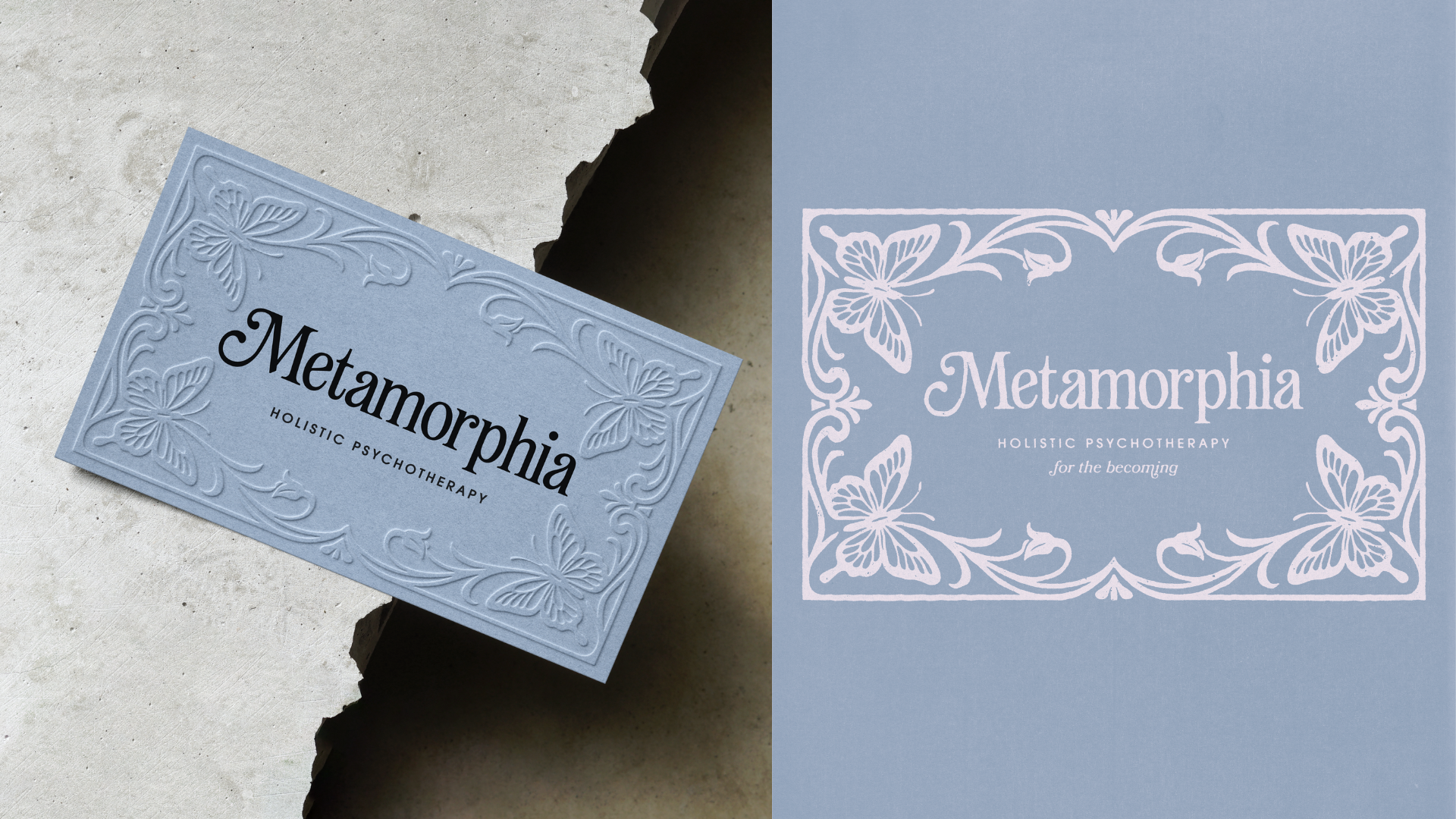
The Deeper Lesson
Both BraveHeart and Metamorphia reflect what happens when branding honors wholeness instead of polarity. They show that science and spirit are not competing languages but complementary expressions of care.
When therapists allow their brands to communicate both intellect and intuition, professionalism and warmth, they begin to show up as whole practitioners. Their presence feels coherent. Their message feels alive.
Authentic branding in the holistic therapy space is not about creating a façade; it is about revealing alignment. When that alignment is visible, a brand ceases to be decoration and becomes something deeper—a reflection of the healing itself.
Frequently Asked Questions About Holistic Therapy Branding
How do I know if my brand feels too spiritual or too clinical?
Notice whether your audience seems unsure about what you actually offer. If clients are confused about your services, your brand may need more structure. If they understand your credentials but seem hesitant to connect, your brand may need more warmth.
Can I use spiritual imagery without alienating clinical clients?
Yes, as long as it reflects your genuine work. Subtle visual cues like light, nature, or texture can convey depth without relying on overt symbolism. The key is authenticity and restraint.
How can I sound credible without sounding corporate?
Use clear, grounded language that emphasizes your expertise while keeping a conversational tone. Avoid jargon, and focus on how your methods support human experiences rather than technical processes.
Should I mention spiritual modalities or certifications first?
You can include both in a way that feels natural. Lead with what feels most authentic to you, then balance it with complementary information.
Do I need to completely rebrand if I have evolved as a therapist?
Not necessarily. Often, small refinements can make a big difference. Updating imagery, tone, or a few lines of copy may be enough to bring everything back into alignment.
What is the difference between aesthetic and authentic branding?
Aesthetic branding focuses on appearance; authentic branding focuses on connection. A brand can look beautiful yet feel hollow if it does not reflect truth. When authenticity leads, aesthetics follow naturally.
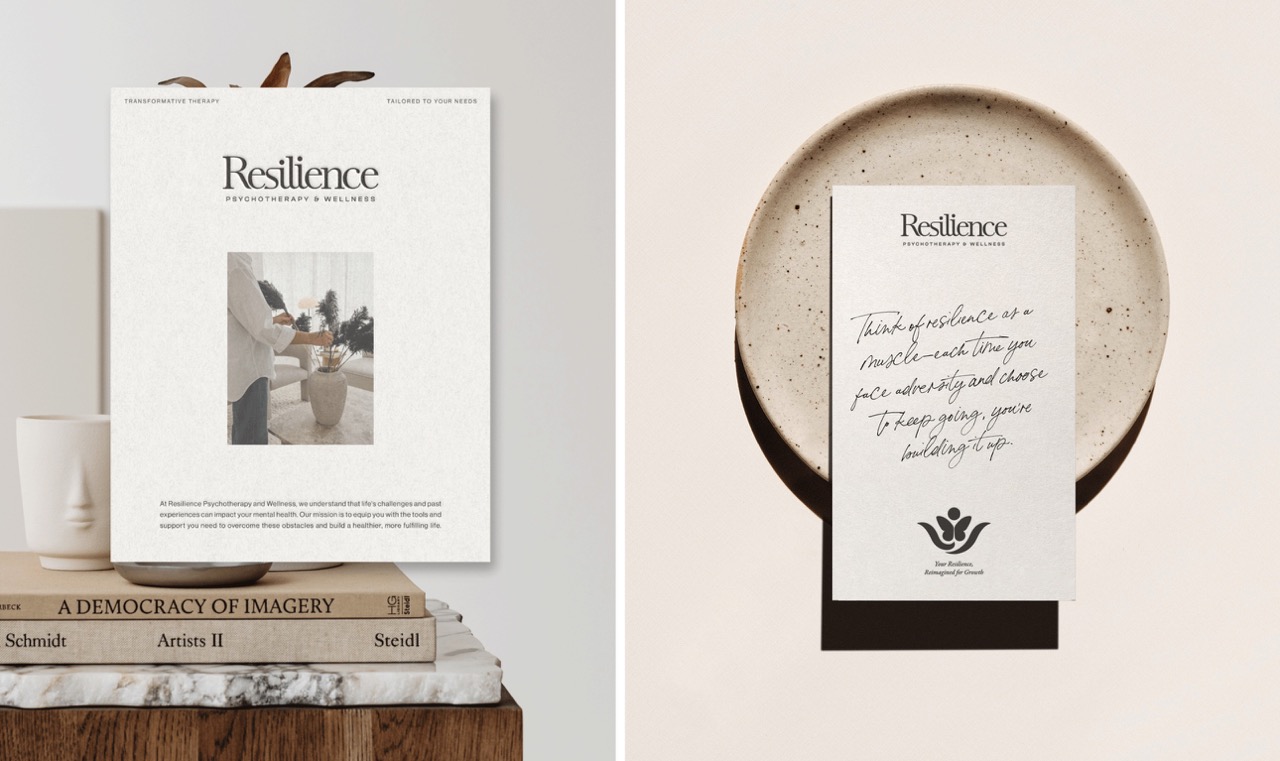
The Future of Therapist Branding Is Integration
Therapists today stand at an extraordinary moment in the profession’s evolution. The walls that once divided science and spirit are slowly dissolving. Clients are seeking practitioners who embody both knowledge and humanity, evidence and empathy.
The path forward is not about choosing between structure and soul. It is about allowing them to coexist within you and within your brand. Integration is not only a marketing strategy; it is a reflection of wholeness.
When your brand reflects the full spectrum of who you are—your training, your intuition, your ethics, and your presence—it becomes more than a business identity. It becomes an offering. Clients feel it. Colleagues respect it. And most importantly, you feel at home within it.
The bridge between science and spirit is not a compromise. It is a homecoming to authenticity.
__________________________________________
Found this helpful? Pin it to your board so you can revisit these tips anytime! 📌


%402x.svg)
%402x.svg)










%402x.svg)